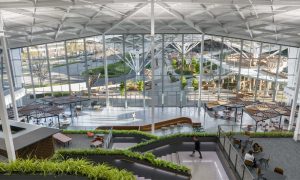Virtual reality
A preview of the completed Masdar City, 14 years ahead of schedule, and an exclusive interview with software developers Vectuel about the future of urban planning. In the year 2000, architecture student Gregory Morlet had an idea. While working on his final assessment, Morlet realised the ideal method to communicate his designs would be to […]

A preview of the completed Masdar City, 14 years ahead of schedule, and an exclusive interview with software developers Vectuel about the future of urban planning.
In the year 2000, architecture student Gregory Morlet had an idea. While working on his final assessment, Morlet realised the ideal method to communicate his designs would be to create a world in which they could exist, before being built.
Inspired by a passion for video games, Morlet created a virtual environment in which his audience could view his project with total freedom of movement and perspective.
The idea was a success and after graduation Morlet developed the platform further.
In 2003 he founded Vectuel, a company which today provides an urban design virtual simulator in real time, VectuelStory.
At the World Future Energy Summit, held in January 2010, the interactive solution also known as VStory, was used to bring the world an exclusive preview of Abu Dhabi’s Masdar City; the world’s first zero carbon city, currently under construction and scheduled for completion in 2025.
Bringing each project to life, VStory communicates all existing and future elements of an urban environment, going as far as to simulate animations such as people, vegetation, traffic and even climatic conditions.
Carrying less data than BIM modelling but more details of the surrounding environment, the virtual solution provides the dual functions of architectural and urban visualisation, for all project collaborators.
Taking four months to produce, the Masdar virtual simulator mapped every aspect of the project, from the underground water pipes, to the interiors of the Personal Rapid Transport (PRT) stations.
The tool allows interaction with every element; from the architectural environment within or from above and additional options to view the project’s utility infrastructure in addition to an overview of how each completed phase will look, step by step.
By modelling the project in an interactive environment, VStory facilitates the production of “large scale, three dimensional models in photo-realistic way or design way, enabling the requirements of decision-making and communication of architectures within urbanism projects”, says the company.
“Our 3D virtual models also integrate the notion of 4D — time criteria — which aims to visualize an environment before and after the insertion of future architecture projects,” explains Vectuel’s Middle East branch manager, Caroline Tasse.
“Thus, we can follow the evolution of a new area and also answer questions about its progress, such as what will this place look like in three, five or 10 years?” She adds.
City of the future
Billed as the “city of the future”, Masdar is a 6km2 development located 17km from UAE capital, Abu Dhabi.
Creating a community of approximately 40,000 residents, 50,000 commuters, hundreds of businesses and a number of research institutions, details such as the integration of the PRT system, renewable energy plants (including 88,000 photo voltaic solar panels) and sustainable technologies have all been mapped virtually using VStory.
“This is a long-term tool which follows the life cycle of a project,” Tasse says. “Firstly it is a work tool; it enables users to simulate, visualise and assess a project in the purpose of validation.
“The second role of 3D interactivity is communication and sales promotion. Easily displayed online, in a showroom and during an exhibition, everybody can discover the future of Masdar City,” she continues.
In contrast to other urban planning models used in many Middle East cities, the aim of Masdar City is to create a fully pedestrianised, liveable space, where residents can walk around naturally shaded streets.
Part of the emirate’s Vision 2030 plans, Masdar CEO Dr Sultan Ahmed Al Jaber, says the city is a demonstration of the sustainable construction ethics enshrined in the Estidama Pearl Rating system.
In addition to using renewable energy sources generated in purpose built facilities, the city will also promote the recycling and reuse of waste, including water. Further to these elements, sustainable materials will be used in the construction; with more than 1800 square metres of sustainably certified timber already sourced for use.
In addition, the resulting buildings will require half the UAE average in power used for cooling.
The first six buildings came into use in September 2010; the one million meter squared Phase 1, comprising the Masdar Institute of Science and Technology, is scheduled for completion by 2015.
With five phases in total, it is expected the city will be fully completed by 2025. According to project director Alan Frost, “it is about pushing the frontiers of science, engineering and technology”.
“The city stakeholders have a strong need for visualising the master plan before commencement of works and identifying mistakes ‘virtually’
in order to rectify them,” adds Tasse. “By testing different options this way, we canproduce a first-class development without supporting the cost of real construction mistakes,” she comments.
“Whatever the urban strategies implemented by the governments are, the need to understand and exchange information is essential, to enable a sustainable urban design and plan, dedicated to a better quality of life for citizens.”
The third dimension
After seven years of operations in Europe, Vectuel Middle East opened a branch in the UAE in 2009 In addition to Masdar City, Vectuel’s virtual simulator has also been used in a number of large scale projects in the UAE for Fujairah Municipality, Abu Dhabi Urban Planning Council, Abu Dhabi Ports Company and Oger International, in addition to town centre and transport projects in Europe.
The company is now looking at further potential applications in the Middle East, with an aim to establish a presence in every GCC country in 2011.
“The 3D technologies and expertise we have developed aim to support major urbanisation and architecture projects at each stage of their development; from the design to the support of decision-makers in the project promotion,” Tasse continues.
In the first instance, Vectuel creates a virtual representation of what already exists, then uses this information to build a model of the project. Facilitating didactic interaction, whereby users can learn about the project from a unique perspective, the planning also encompasses environmental aspects such as traffic, weather and the overall impact of the project on its surroundings.
In addition to allowing project collaborators an exclusive insight, the software can also be used to present to audiences who may invest or be concerned with the completed development.
“Here in the UAE, 3D interactivity is a relevant tool for architects to introduce projects towards various sections of the public who often are not experts in architecture, urbanism, or geographic information.
“Facing the redesign of master plans and implementation of new transport systems, the whole challenge cities face in the UAE and other countries in the region today is the need to acquire tools to lead this change,” Tasse says.
“Consequently, the main focus is on understanding the existing environment in order to keep developing.”

























